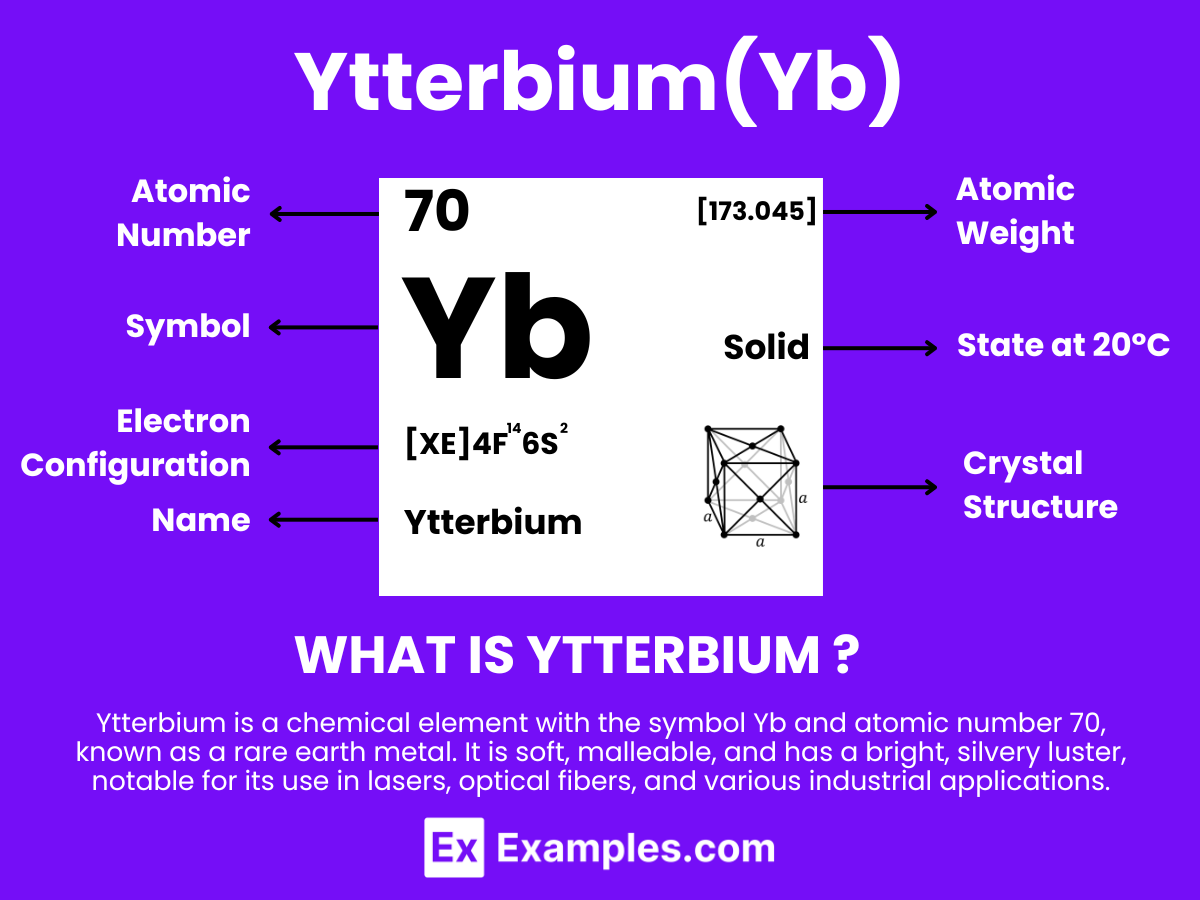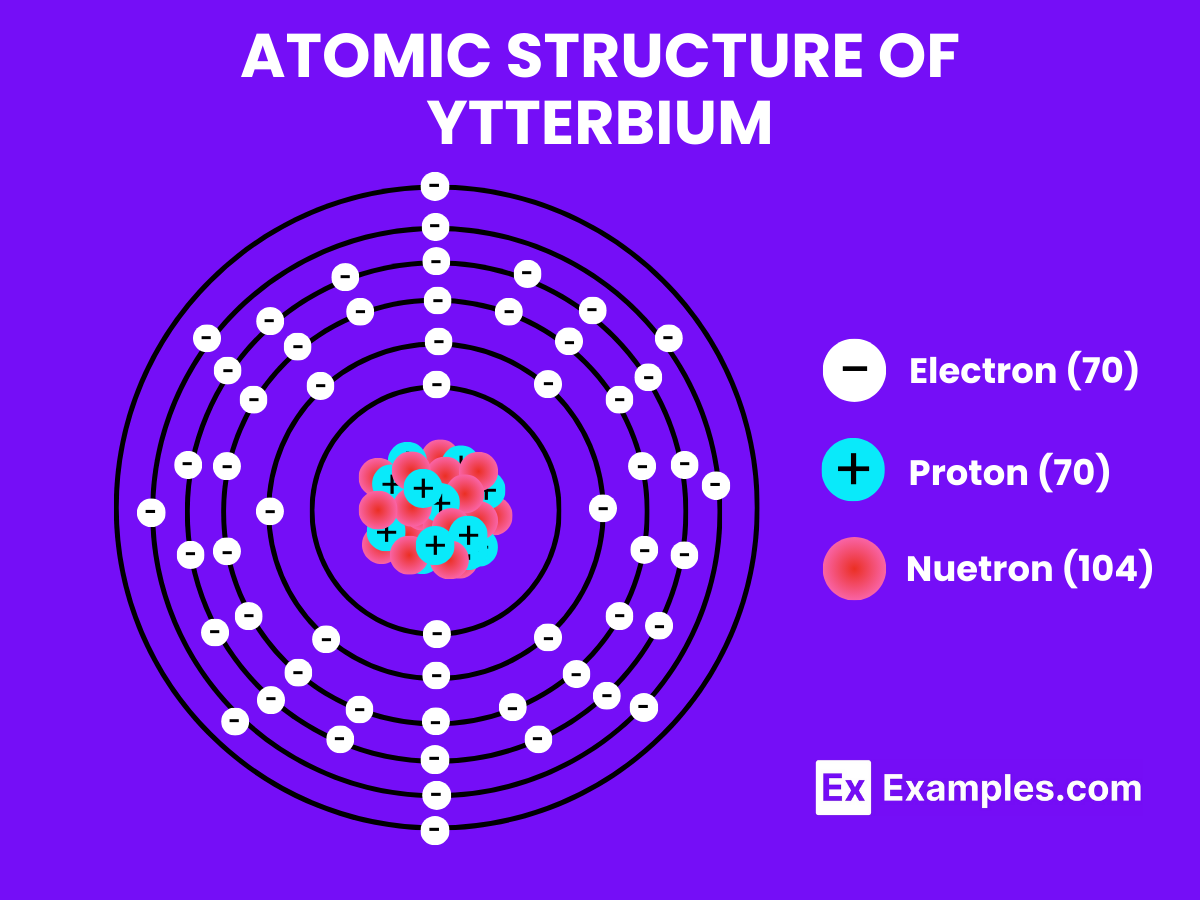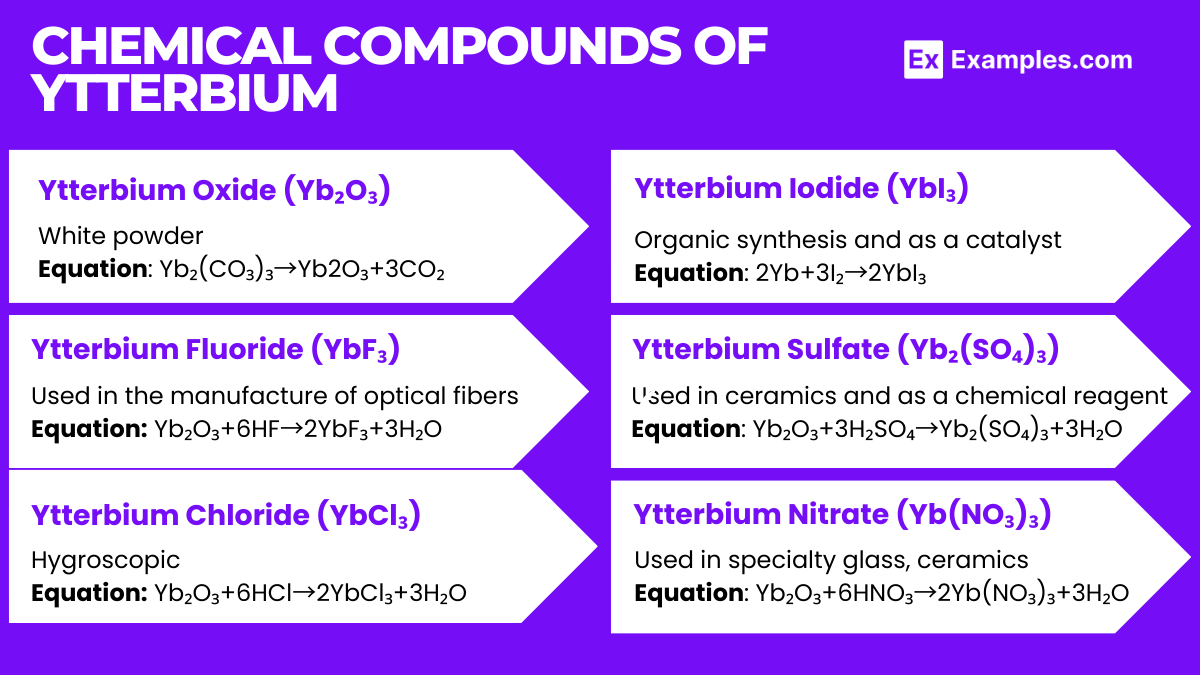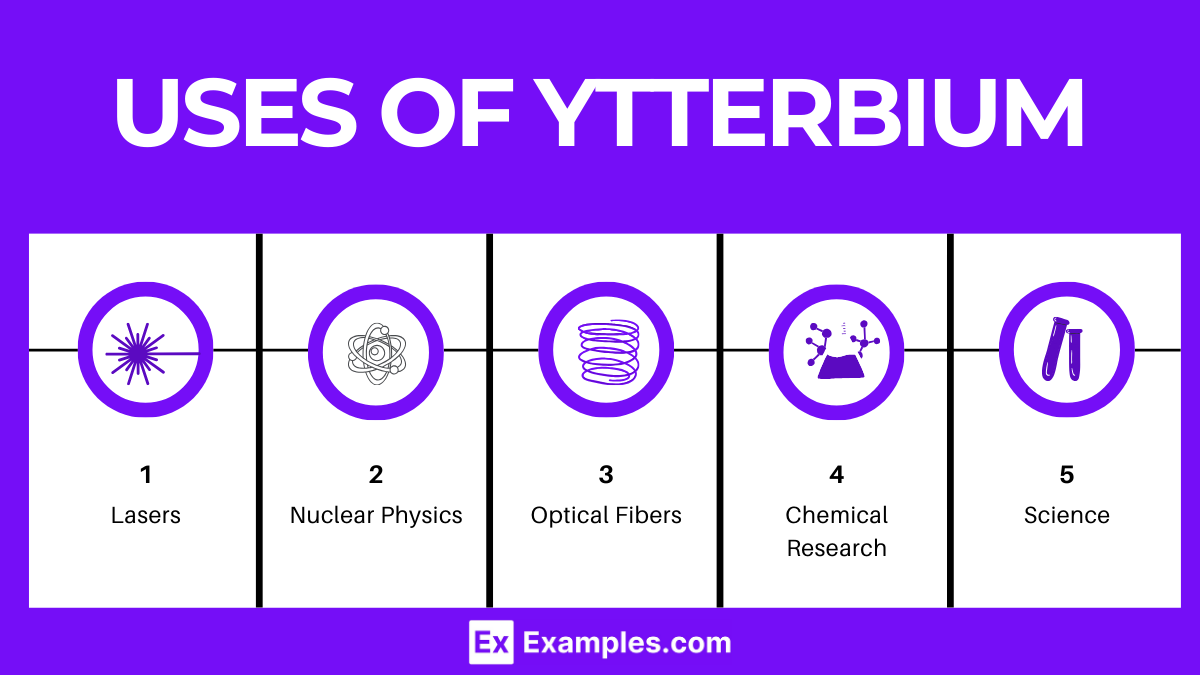Ytterbium
On an enlightening exploration of Ytterbium, a fascinating element with a silver gleam that hides a wealth of applications beneath its modest exterior. This complete guide illuminates Ytterbium’s essential characteristics, from its definition and fundamental meaning to its myriad uses in technology and science. We’ll delve into its various compounds, providing examples that showcase Ytterbium’s versatility and pivotal role in advancing modern innovations. Whether you’re a seasoned scientist or simply curious about the elements, this guide to Ytterbium offers a rich, keyword-enriched narrative designed to enhance your understanding and appreciation of this remarkable element.
What is Ytterbium ?
Ytterbium is a chemical element with the symbol Yb and atomic number 70. It belongs to the lanthanide series, a subset of the rare earth elements, in the periodic table. Ytterbium is a soft, malleable, and ductile metal with a bright, silvery luster. It exhibits a relatively high density and is stable in air due to the formation of a surface oxide layer that prevents further oxidation.
In its natural state, ytterbium is found in several minerals, including xenotime, monazite, and euxenite, usually in small amounts. It is not found in a free state in nature. The element was discovered by the Swiss chemist Jean Charles Galissard de Marignac in 1878 through his work on erbium oxide.
Ytterbium Formula
- Formula: Yb
- Composition: Consists of a single ytterbium atom.
- Bond Type: In its elemental form, ytterbium does not form bonds as it is a pure element. However, ytterbium can participate in covalent or ionic bonding when reacting with other elements, due to its chemical properties as part of the lanthanide series.
- Molecular Structure: As a pure element, ytterbium does not present a molecular structure in the traditional sense of compounds. Due to its metallic nature, it is hypothesized that ytterbium would exhibit a metallic state with a crystalline structure, which is typically face-centered cubic (fcc) for ytterbium.
- Electron Sharing: In compounds, ytterbium is expected to share electrons covalently or engage in ionic electron transfer with other elements. This behavior is typical for lanthanides, which can form a variety of compounds, displaying both ionic and covalent bonding characteristics.
- Significance: Ytterbium’s significance lies in its applications driven by its unique properties among the lanthanides, such as in lasers, optical fibers, and electronic materials. While not as widely used as some other elements, its specific uses in certain high-tech areas highlight the importance of ytterbium in modern technology and materials science.
- Role in Chemistry: The role of ytterbium in chemistry includes its use in various applications such as in solid-state lasers, fiber optic amplifiers, and as a dopant in certain materials to improve their properties. Its chemistry is characterized by the +2 and +3 oxidation states, with the +3 oxidation state being the most common. Investigations into ytterbium and its compounds help to broaden our understanding of rare earth chemistry and its application in advanced technologies and material sciences
Atomic Structure of Ytterbium
Ytterbium, in contrast to hydrogen, is a metallic element with characteristics that reflect its position within the lanthanide series of the periodic table. Its properties include a metallic luster, malleability, and conductivity, which significantly diverge from the gaseous nature and simple molecular formation of hydrogen. Ytterbium’s behavior at the atomic and molecular levels is influenced by its electronic structure and its role in various chemical and physical processes.
Atomic Level: Each ytterbium atom (Yb) contains 70 protons in its nucleus and is expected to have 70 electrons orbiting around it. The electron configuration of ytterbium is predicted to be [Xe] 4f¹⁴ 6s², indicating a completed 4f shell and suggesting stability and a low level of chemical reactivity compared to other elements. This stable electron configuration leads to ytterbium’s common +2 and +3 oxidation states, with the +3 state being more prevalent and chemically active.
Molecular Formation: Unlike hydrogen, which forms simple diatomic molecules (H₂) through covalent bonding, ytterbium, due to its metallic nature, would not form molecules in a similar manner. In its solid form, ytterbium is expected to exhibit a metallic lattice structure typical of metals. This structure involves metallic bonding, where electrons are delocalized over many ytterbium atoms, differing fundamentally from the discrete electron sharing seen in hydrogen’s covalent bonds. The crystalline structure of solid ytterbium is usually face-centered cubic (fcc), common among some rare earth metals
Properties of Ytterbium
Physical Properties of Ytterbium
| Property | Value |
|---|---|
| Atomic Number | 70 |
| Atomic Weight | 173.04 g/mol |
| Density | 6.90 g/cm³ |
| Melting Point | 824 °C |
| Boiling Point | 1196 °C |
| State at 20°C | Solid |
| Color | Silvery-white |
Chemical Properties of Ytterbium
Ytterbium is a rare earth metal with interesting chemical properties, predominantly existing in the +2 and +3 oxidation states, though the +3 state is more stable and common. It reacts slowly with water and quickly with acids to form ytterbium salts. Below are examples with relevant equations:
- Reaction with Water:
H₂
Ytterbium reacts with water to form ytterbium hydroxide and hydrogen gas, though this reaction is less vigorous compared to other reactive metals.
- Reaction with Acids:
H₂
Ytterbium dissolves in hydrochloric acid, forming ytterbium chloride and hydrogen gas.
- Reaction with Air:
Thermodynamic Properties of Ytterbium
| Property | Value |
|---|---|
| Standard Molar Entropy (S°298) | 49.7 J/(mol·K) |
| Heat of Fusion | 7.66 kJ/mol |
| Heat of Vaporization | 159 kJ/mol |
| Thermal Conductivity | 38.5 W/(m·K) |
| Specific Heat Capacity | 26.74 J/(mol·K) |
| Thermal Expansion | 26.3 µm/(m·K) |
| Debye Temperature | 129 K |
Material Properties of Ytterbium
| Property | Value |
|---|---|
| Young’s Modulus | 23.9 GPa |
| Shear Modulus | 9.9 GPa |
| Bulk Modulus | 30.5 GPa |
| Poisson’s Ratio | 0.207 |
| Mohs Hardness | 2-3 |
| Vickers Hardness | 345 MPa |
| Brinell Hardness | 343 MPa |
| Electrical Resistivity | 0.250 µΩ·m (at 20 °C) |
Electromagnetic Properties of Ytterbium
| Property | Description |
|---|---|
| Electronic Configuration | [Xe] 4f¹⁴ 6s² |
| Magnetic Ordering | Paramagnetic |
| Electrical Conductivity | Good conductor of electricity |
| Optical Properties | Ytterbium ions can be used in lasers for their ability to absorb and emit light efficiently |
| Superconductivity | Exhibits superconductivity under certain low-temperature conditions |
Nuclear Properties of Ytterbium
| Property | Description |
|---|---|
| Natural Isotopes | Yb-168, Yb-170, Yb-171, Yb-172, Yb-173, Yb-174, and Yb-176 |
| Radioactive Isotopes | Yb-169, Yb-175, and others with shorter half-lives |
| Stable Isotopes | Yb-168, Yb-170, Yb-171, Yb-172, Yb-173, Yb-174, and Yb-176 |
| Neutron Cross Section | Yb-174 has a high neutron absorption cross-section, useful in certain nuclear applications |
| Isotopic Abundance | Ytterbium has a natural mix of isotopes, with Yb-174 being the most abundant in nature |
| Half-lives | Ranges from days for the lightest isotopes to potentially stable for the heavier isotopes |
Preparation of Ytterbium
The preparation of ytterbium typically involves several steps, starting from its ores, such as monazite and xenotime, which contain a mixture of rare earth elements. The process includes:
- Ore Processing: The ores are initially treated with acid (usually sulfuric acid) to dissolve the rare earth elements.
- Separation: The ytterbium is then separated from other rare earth elements through solvent extraction or ion exchange techniques. This involves multiple stages to ensure the purity of ytterbium.
- Metallic Reduction: Finally, ytterbium is reduced to its metallic form. This is often achieved using either electrolysis of ytterbium fluoride (YbF3) or reduction with calcium in a vacuum:
- Electrolysis:
F⁻
- Reduction with Calcium:
- Electrolysis:
Chemical Compounds of Ytterbium
Ytterbium forms a variety of compounds, mainly in the +3 oxidation state. Below are some key ytterbium compounds, their preparation equations, and properties:
- Ytterbium Oxide (Yb)
- Preparation: Heating ytterbium carbonate.
b₂
- Properties: White powder, used in ceramics and as a dopant for phosphor materials.
- Preparation: Heating ytterbium carbonate.
- Ytterbium Fluoride (YbF)
- Preparation: Reacting ytterbium oxide with hydrofluoric acid.
₂
- Properties: Used in the manufacture of optical fibers and lasers.
- Preparation: Reacting ytterbium oxide with hydrofluoric acid.
- Ytterbium Chloride (YbCl)
- Preparation: Dissolving ytterbium oxide in hydrochloric acid.
- Properties: Hygroscopic, used in chemical research and materials science.
- Ytterbium Iodide (YbI)
- Preparation: Direct reaction of ytterbium with iodine.
- Properties: Used in organic synthesis and as a catalyst.
- Ytterbium Sulfate (Yb)
- Preparation: Reaction of ytterbium oxide with sulfuric acid.
- Properties: Used in ceramics and as a chemical reagent.
- Ytterbium Nitrate (Yb(NO₃)
- Preparation: Dissolving ytterbium oxide in nitric acid.
- Properties: Used in specialty glass, ceramics, and as a precursor for other ytterbium compounds
Isotopes of Ytterbium
| Isotope | Natural Abundance (%) | Half-Life | Decay Mode |
|---|---|---|---|
| Yb-168 | 0.13 | Stable | – |
| Yb-170 | 3.04 | Stable | – |
| Yb-171 | 14.28 | Stable | – |
| Yb-172 | 21.83 | Stable | – |
| Yb-173 | 16.13 | Stable | – |
| Yb-174 | 31.83 | Stable | – |
| Yb-176 | 12.76 | Stable | – |
| Yb-169 | Trace | 32.026 days | Electron capture |
| Yb-175 | Trace | 4.185 days | Beta decay |
| Yb-177 | Trace | 1.911 hours | Beta decay |
Uses of Ytterbium
- Lasers: Ytterbium is used in doping yttrium aluminum garnet (YAG) lasers, providing efficient and powerful lasers for industrial cutting and welding applications.
- Nuclear Physics: The stable isotope Yb-176 is used as a target material in nuclear physics experiments.
- Optical Fibers: Ytterbium-doped optical fibers enhance the performance of fiber optic communication systems by amplifying the signals.
- Radiation Source: Ytterbium-169 is used in portable X-ray machines as it emits X-rays when it decays, suitable for medical diagnostics.
- Material Science: Ytterbium compounds, like ytterbium fluoride, are used in manufacturing special glasses and ceramics with unique optical properties.
- Chemical Research: Ytterbium catalysts are employed in organic synthesis, facilitating certain types of hydrogenation and dehydroxylation reactions.
- Quantum Computing: Research into ytterbium ions’ potential for use in quantum computing and information storage due to their favorable quantum mechanical properties.
- Meteorology: Ytterbium isotopes are used in the study of geological and meteorological processes, aiding in the dating and analysis of meteorites and terrestrial samples
Production of Ytterbium
Ytterbium, a rare earth element with the symbol Yb and atomic number 70, is not found free in nature but is contained in several minerals, including monazite, xenotime, and euxenite. The production of ytterbium typically involves several steps, starting from the mining of ytterbium-containing minerals.
- Mining and Extraction: The first step in the production of ytterbium is the mining of ores that contain rare earth elements, with monazite and xenotime being among the most common sources. These ores are then subjected to various processes to extract the mixed rare earth elements.
- Separation of Rare Earth Elements: Since ytterbium is mixed with other rare earth elements in the ores, it must be separated through solvent extraction or ion exchange techniques. This process involves dissolving the ores in acid, then selectively separating ytterbium from the other elements using chemical reactions that take advantage of the slight differences in their chemical properties.
- Reduction to Metallic Form: Once ytterbium has been separated in its pure form, it is usually converted into ytterbium fluoride (YbF3) or ytterbium chloride (YbCl3) before being reduced to metallic ytterbium. The reduction process often involves using calcium or lithium as reducing agents in a high-temperature environment, resulting in pure ytterbium metal.
- Refining: The metallic ytterbium obtained from the reduction process can further be refined to achieve higher purity levels through vacuum distillation or other refining techniques
Applications of Ytterbium
Ytterbium has a range of applications due to its unique properties, including its ability to emit infrared light, its high density, and its electrical conductivity. Some of its notable applications include:
- Fiber Optic Communications: Ytterbium is used as a doping agent in fiber optic cables to enhance signal strength in telecommunications. Ytterbium-doped fibers are used in fiber lasers and amplifiers because of their ability to efficiently convert electrical power into laser light in the 1 µm wavelength range, which is ideal for optical communications.
- Lasers: Ytterbium lasers are known for their high power and efficiency, making them suitable for a variety of industrial applications, including cutting, welding, and marking of materials. Ytterbium lasers operate in the near-infrared range and are used in medical procedures and research.
- Material Science: Due to its electrical properties and ability to absorb X-rays, ytterbium is used in various alloys and compounds to enhance their physical properties. It is also used in certain types of radiation detectors and in the production of special glasses and ceramics.
- Nuclear Physics: Ytterbium isotopes are used as targets in nuclear physics experiments. The isotope Ytterbium-176 is used in studies related to the synthesis of superheavy elements, and certain isotopes of ytterbium are used in the study of the structure of atomic nuclei.
- Medicine: Ytterbium isotopes are explored for potential use in cancer therapy, particularly in neutron capture therapy, where its ability to capture neutrons and release localized radiation could be used to kill cancer cells without harming surrounding healthy tissue.
Article extensively covers ytterbium, from its fundamental isotopes to its myriad uses across technology, medicine, and science. Through detailed exploration of its preparation, chemical compounds, and unique properties, we’ve showcased ytterbium’s integral role in enhancing lasers, optical fibers, and even quantum computing. Ytterbium emerges as a pivotal element, driving innovation and advancing research in multiple disciplines, demonstrating its versatility and essential contribution to modern technology.






